
‘Among the great figures in animated film, Lotte Reiniger stands alone. No one else has taken a specific animation technique and made it so utterly her own. To date she has no rivals, and for all practical purposes the history of silhouette animation begins and ends with Reiniger. Taking the ancient art of shadow-plays, as perfected above all in China and Indonesia, she adapted it superbly for the cinema.
‘She was born in Berlin to cultured parents, and from an early age showed an exceptional and, it seems, self-taught ability to cut free-handed paper silhouettes, which she used in her own home-made shadow-theatre. Initially she planned to be an actress, studied with Max Reinhardt, and used her skill at silhouette portraiture to attract the attention of the film director Paul Wegener. He invited her to make silhouettes for the intertitles to his films Rübezahls Hochzeit (Germany, 1916) and Der Rattenfänger von Hameln (Germany, 1918).
‘Wegener introduced Reiniger to a group of young men who were setting up an experimental animation studio, the Berliner Institut für Kulturforschung, headed by Hans Cürlis. One member of the group was the film historian Carl Koch. In 1919 she made her own first film for the institute, Das Ornament des verliebten Herzens (The Ornament of a Loving Heart). In 1921 Reiniger married Koch, who designed her animation studio and became her producer and camera operator until his death in 1963.
‘From the first, Reiniger was attracted to timeless fairy-tale stories for her animations. Aschenputtel (Cinderella) and Dornröschen (The Sleeping Beauty) (both 1922) were among her earliest subjects. The avant-garde artist and filmmaker Hans Richter, a lifelong friend, wrote of her that “she belonged to the avant-garde as far as independent production and courage were concerned,” but that the spirit of her work harked back to an earlier, more innocent age. Jean Renoir, another close friend and passionate admirer of her work, described her films as a “visual expression of Mozart’s music”. Indeed Mozart, and other operatic themes, often provided her with subjects, as in such films as Carmen (Germany, 1933), Papageno (Germany, 1935), Helen La Belle (1957, drawing on Offenbach) and A Night in a Harem (1958, drawing on Mozart).
‘From 1923 to 1926, Reiniger worked with Carl Koch, Walther Ruttmann and Berthold Bartosch on her most famous work, The Adventures of Prince Achmed, often credited as the first full-length animated film. Financing for this project was provided by a young Berlin banker, Louis Hagen, who had seen and admired her previous work. When inflation attacked the Deutschmark in 1923, Hagen had converted some of his money into film stock which he then offered to Reiniger to make a feature-length film on any subject she chose. He also built a studio for her above the garage of his house in Potsdam.
‘After completing Prince Achmed while still in her twenties, Reiniger never again attempted a feature-length animated film; for the rest of her sixty-year career she concentrated on shorts, mostly of one or two reels in length, and on sequences to be inserted in other people’s films. (She also co-directed, with Rochus Gliese, a part-animation, part-live-action feature, Die Jagd nach dem Glück (Running After Luck) (Germany, 1929), but it was a commercial and critical failure.) When funding ran short she would resort to book illustrations or commercials. As early as 1922 she made Das Geheimnis der Marquise (The Marquise’s Secret) for Nivea skincare products.
‘Altogether Reiniger made nearly sixty films, of which some forty survive. Her technique, already amazingly accomplished in Prince Achmed, gained yet further in subtlety and balletic grace during the Thirties in such films as Harlekin (Harlequin, 1931) and Der kleine Schornsteinfeger (The Little Chimney Sweep, 1934). The delicacy and fantasy of fairy-tales suited her intricate, imaginative technique, and they make up the bulk of her output.
‘After the Nazis seized power Reiniger turned her back on Germany, “because I didn’t like this whole Hitler thing and because I had many Jewish friends whom I was no longer allowed to call friends”. In December 1935 she and Koch came to England where they made The King’s Breakfast (1936) for John Grierson and other films for the GPO Film Unit. She also contributed a shadow-play sequence to Renoir’s La Marseillaise (France, 1937).
‘At the outbreak of war Koch was in Rome working with Renoir. Reiniger joined him there and worked as his assistant on La Tosca (Italy, 1941, completed by Koch after Renoir quit Italy in haste) and Una signora dell’ovest (Italy, 1942). At Christmas 1943 they reluctantly returned to Berlin to care for Reiniger’s sick mother. Her only film during the war years was Die Goldene Ganz (The Golden Goose, 1944). Many of the original negatives stored in her Potsdam studio were destroyed by a hand-grenade blast. Luckily prints existed elsewhere and it was possible to reconstitute the majority of her films, including Prince Achmed.
‘After the war, the couple took British citizenship and settled in the Abbey Arts Centre, an artists’ estate in north London, where they set up Primrose Productions along with Louis Hagen Jr, son of the Berlin banker who had financed Prince Achmed. This was the most intensely productive period of Reiniger’s career: in two years she created a dozen films for American television, all adapted from classic fairy tales by the Brothers Grimm, Wilhelm Hauff, Hans Christian Andersen and from the One Thousand and One Nights. The Gallant Little Tailor (1954) was awarded a prize, the Silver Dolphin, at the Venice Festival.
‘After Carl Koch’s death in 1963 Reiniger made no films for ten years, becoming a near-recluse. But her films were enjoying a revival, and in 1969 she was invited to visit her native country for the first time since her emigration. This led to a rediscovery of her film works in West Germany and to late recognition: in 1972 the artist was awarded the Filmband in Gold and in 1979, on her 80th birthday, she received the Bundesverdienstkreuz (Order of Merit).
‘In the early 70s Reiniger was persuaded to embark on a lecture tour of North America, where she described herself as “a primitive caveman artist”. Inspired by the warmth and affection she encountered, she resumed work, and in her last years made two films for Canada, including the exquisite The Rose and the Ring (1979) from the story by Thackeray. This, her penultimate film, showed that her 80-year-old fingers had lost none of their magic. Reiniger’s final film was a very brief short, Die vier Jahreszeiten (The Four Seasons, 1980), made for the Filmmuseum Düsseldorf the year before she died.’ — Philip Kemp
___
Stills
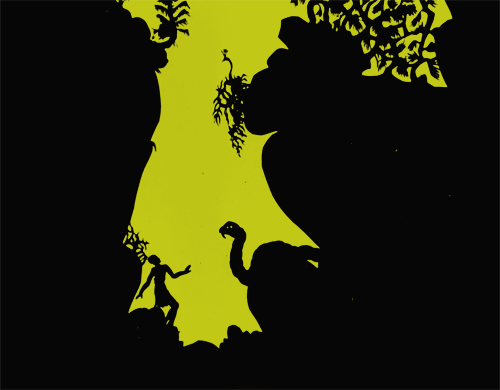
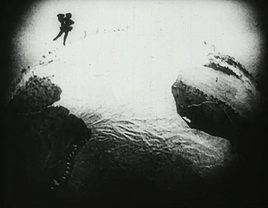

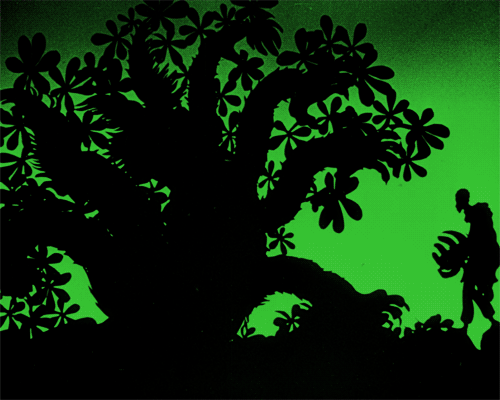





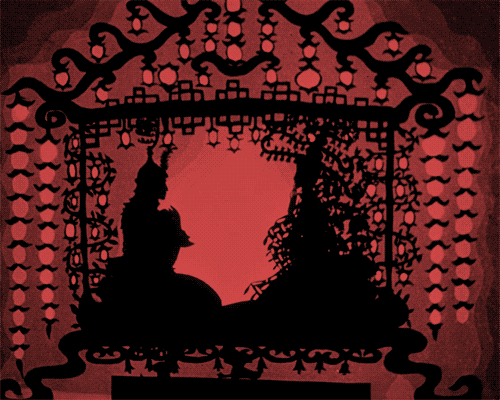




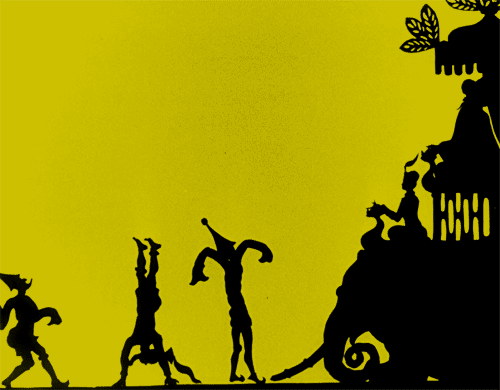




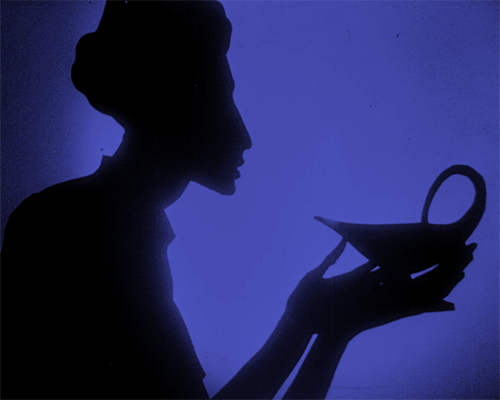
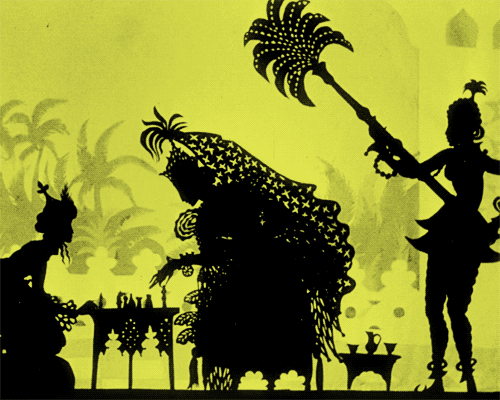
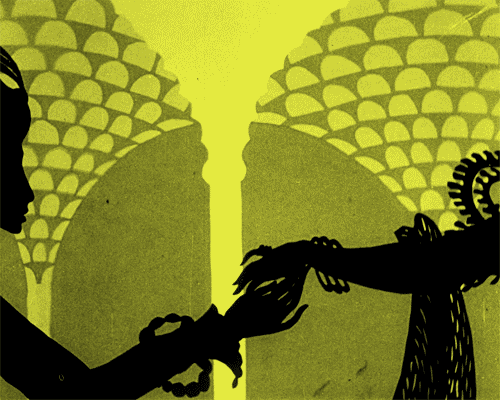

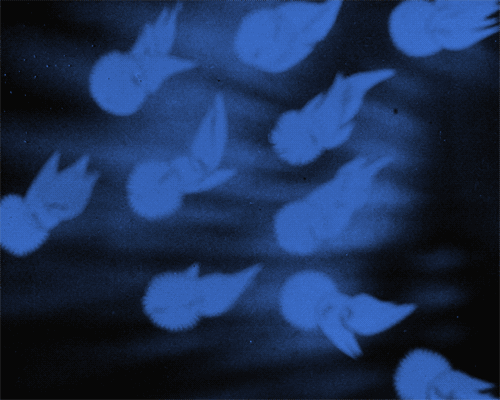
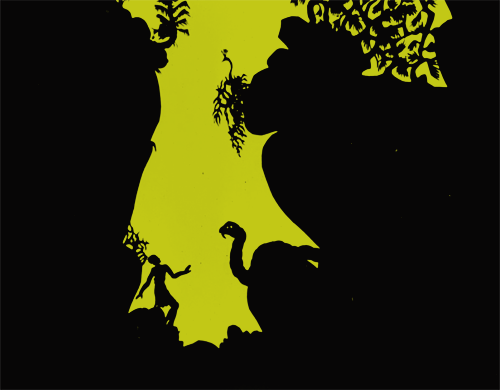




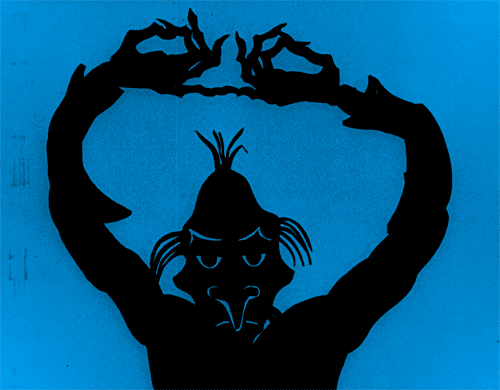
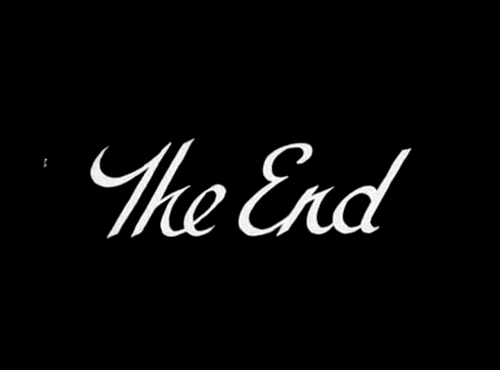

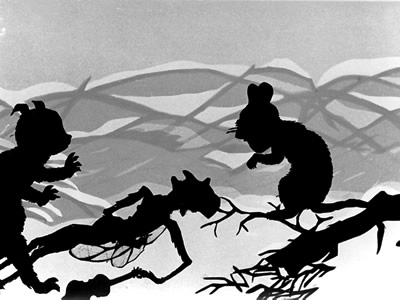
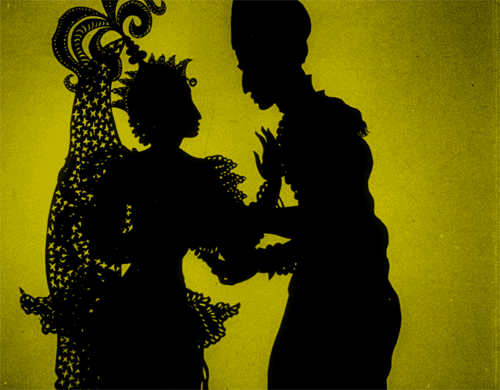








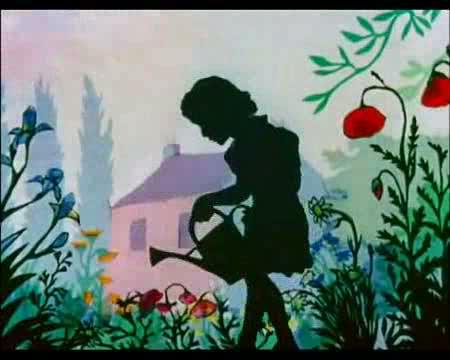
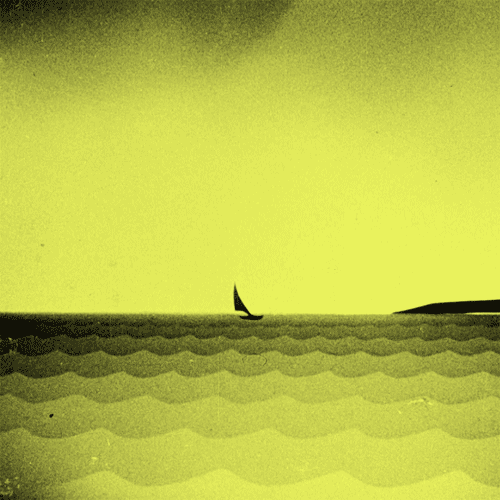



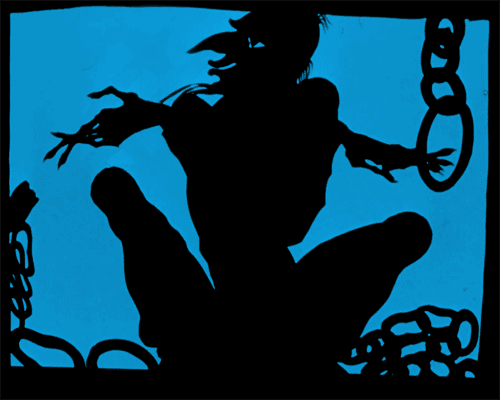

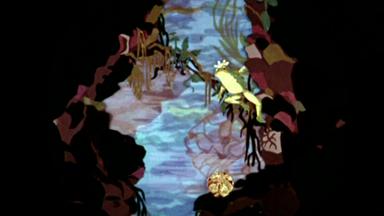
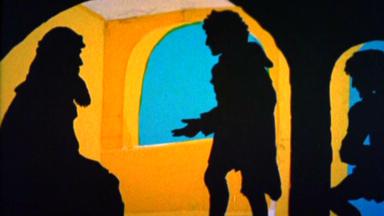
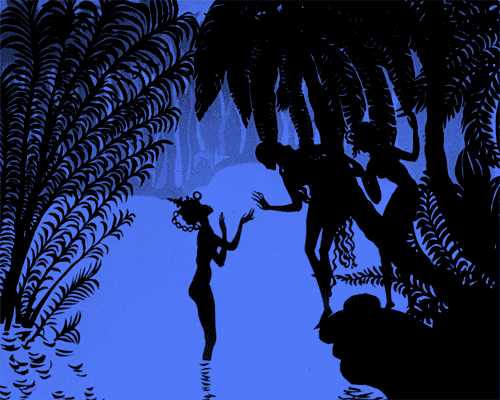
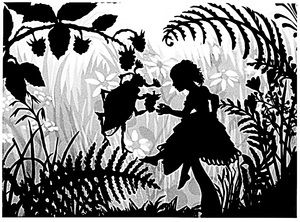





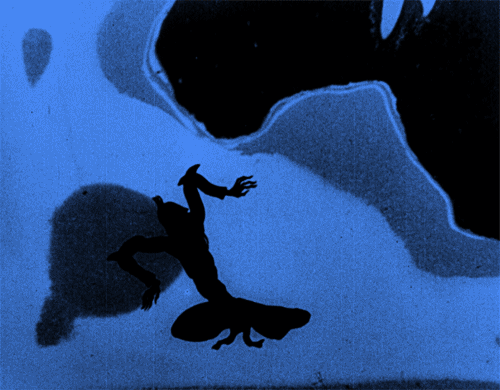
____
Further
Lotte Reiniger Website
Lotte Reiniger @ IMDb
Lotte Reiniger @ Animation World Network
‘The Groundbreaking Silhouette Animations of Lotte Reiniger’
‘TEN YEARS BEFORE DISNEY’
‘Animation: Reiniger’s Prince Achmed’
‘The Adventures of Lotte Reiniger – the early years of film animation in Germany’
‘Listen to Lotte Reiniger and Rebecca Sugar Discuss Animation’
Lotte Reiniger page @ Facebook
‘In the Shadows: Lotte Reiniger’
‘On the master animator Lotte Reiniger’
‘Figuras de cine: Lotte Reiniger’
‘How can we understand Lotte Reiniger’s fantasy fairy-tales in context?’
‘Forgotten but not gone’
____
Extras
The Art of Lotte Reiniger
advertisement for Nivea skin care by Lotte Reiniger, 1922
Priceless old footage of Lotte Reiniger speaking about her method
Lotte Reiniger im Stadtmuseum Tübingen
____
Quotes
“I believe in the truth of fairy-tales more than I believe in the truth in the newspaper.”
“Film is movement. It’s the combination of curves and diagonals that gives ballet and animation their sweet tenderness and their striking directness. Even with primitive materials, one can work small wonders.”
“Hands are practically the only way to show a silhouette figure’s emotions. Without all five fingers, it’s not so good.”
“I do make a point to include animal silhouettes because in animation films, man and beast are on the same level, which would be impossible on a theatrical stage. In my research, I’ll spend hours at the zoo, then return to my studio. Sometimes I will get down on all fours to imagine what it would feel like to be a particular animal.”
“I love working for children, because they are a very critical and very thankful public.”
“Walt Disney’s animations obey the rules of perspective, fooling the eye to see three dimensions. I am skeptical of Disney and his factorystyle, over-technicized productions. Our films may be more modest, but they bear a more individual mark. I feel that the stark black figures in our films stimulate audience imagination more than lush colors.”
“Deutsche Filmzeitung [the Third Rech trade journal] disparaged my films as romantic and unrealistic. In a private conversation, I was told, ‘We need healthy produce for the German people. What you make is a caviar in which we have no interest.'”
_____
At work








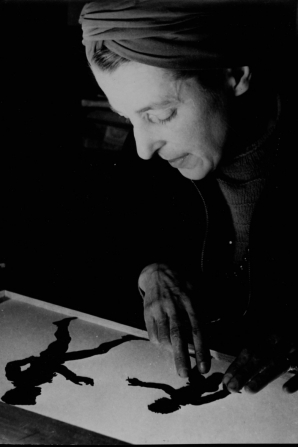

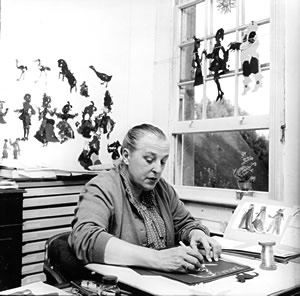





_____________
16 of Lotte Reiniger’s 59 films
______________
Cinderella (1922)
‘It all begins with a pair of scissors cutting out Cinderella from a piece of black card before placing her into the world of the story. In many shots, the action is vignetted by jagged edges, reminding us of the sharp edges that have crafted the materials of this tale. Animation is already well suited to fairy tales, which have provided story material for Reiniger, Jiří Trnka, Ladislas Starevich, Ray Harryhausen, Jan Švankmajer and that Disney bloke (Disney also released a cartoon of Cinderella in 1922, and a feature film of the same story in 1950, four years before Reiniger’s own remake). Animation allows the construction of a completely fabricated fantasy space that is bracketed off from the real world, evoking the enclosures of memory and imagination (though I might argue that Disney’s approach was less to do with evoking the imaginative and ephemeral experience of fairytales, and more about reshaping those tales in order to fit into the house style of his company). Animated figures provide archetypal rather than definitive renderings of fairytale characters, and particularly in Reiniger’s monochromatic stories, the images allow space for the viewer’s imagination to fill in the gaps.’ — Dr. North
the entire film
________________
The Adventures of Prince Achmed (1926)
‘Paul Shallcross, who today played the lovely score he composed for the film, gave an excellent introduction as to why the film has historically been revered as a landmark: the youth of the director, the painstaking mode of animation involving cardboard silhouettes and thin sheets of lead which took three years to complete, how each frame was lit from below and photographed from above using layered backgrounds one painstaking frame after another, how famous avant-garde figures such as Walter Ruttmann, Berthold Bartosch and Carl Koch worked on the film etc. But personally, I always thought there was a reason why silhouette films never took off. It always felt too much like a successful attempt in gaining maximum expressivity from a limited vocabulary; and why bother? The images are delicate and pretty. The story, from the Arabian nights and featuring Aladdin, his lamp, witches, sorcerers, dragons, warriors and princesses — and a setting ranging from the Middle East to China — is exciting and involving. But why not tell the same story using a greater visual vocabulary that allowed more movement and a greater range of expression? Today I got my answer.’ — Notes on Film
the entire film
________________
Der scheintote Chinese (1928)
‘A bit racist (a lot racist), but stunningly animated. The story is actually very strange (though more or less normal for a fairytale), and I could not parse any clear moral from it (though there’s nothing say it’s a fable). Perhaps I need to think on it more, or perhaps I missed something while drooling over the silhouettes.’ — letterboxd.com
the entire film
_______________
Galatea: The Living Marble Statue (1935)
‘The Greek legend of Pygmalion and Galatea get the Lotte Reininger silhouette treatment in this lovely and funny adaptation of the old Greek myth. Pygmalion falls in love with his statue of a beautiful woman and his prayers are answered: she becomes a live woman — in this case she transforms from part of the painted background into one of Reininger’s silhouette figures. But Pygmalion, who has conventional ideas of how women should behave, finds that his creation has different ideas of what she wants….
‘Lotte Reininger’s silhouettes may be difficult to follow, since the aesthetics involved are different from standard movies: but the beauties of her details and her sense of humor should be enough to draw you in, should you be fortunate enough to see them.’ — Dangerous Minds
the entire film
_______________
Papageno (1935)
‘An example of Lotte Reiniger’s animated music films based on opera, PAPAGENO is filled with impeccable attention to detail. Papageno, a bird catcher from Mozart’s “The Magic Flute,” idles away the time with his avian companions, fights an undulating snake, and finds love and family happiness through delicate and delightful visuals that parallel the rhythm and expressivity of the music.’ — The Criterion Channel
the entire film
______________
Puss in Boots (1936)
‘I was perhaps too hasty in bemoaning the stiffness of Reinige’s animation. It’s been a long time since I watched Prince Achmed, but I bet it’s much the same, a part of the silhouette style she uses. When I first watched Prince Achmed, everything about the style infused me with awe. As I watched this, the continuing of that stiffness prompted vague memories of the same, so I think I just needed to reacquaint myself. The combination of shadowplay and beautifully sketched backgrounds remains delightful. My other thought is how much I like trickster characters. Puss in Boots is a beautiful example of a trixter whose cunning is used in defense of the meek, or the working man, or the maltreated. It’s not a perfect fairytale telling–there’s no effort given to making anything more if than its bare bones, so the princess is just a reward, for instance–but the crux of it is a poor young man being aided in gaining power and resource. It’s couched in medieval trappings, but there’s a socialistic idea that can be scratched out if you try.’ — letterboxd.com
the entire film
________________
Mary’s Birthday (1951)
‘It’s no accident that the villains in this 1951 English children’s animated short about proper hygeine swarm suspiciously like the Luftwaffe during the London Blitz that happened a decade earlier: the film was made by Lotte Reiniger, the German-born filmmaker who fled from the Nazis (not Jewish, she understood the implications for artists) in 1933 and eventually settled permanently in England. The specter of war is still very much present in this otherwise idyllic-looking little film. There’s also something vaguely forward-looking and existentialist in the grooming habits and postures of Bertram, who is literally lord of the flies in this plotline. Some have interpreted the working-class accents of the flies & germs with Labour or with the union-organizing movement. There is a distinct association of caste and accent with heroism in this. Really interesting little trove of memes here.’ — Thimble Wicket
the entire film
______________
The Magic Horse (1953)
‘An untrustworthy old man – a magician – presents a ruler with a magical mechanical horse that can fly through the air. And the Caliph’s son wants to take a ride. The innovative German animator Lotte Reiniger created this evocative 10-minute film in 1953, using silhouette paper cutouts and stop-motion animation.’ — Deceptology
the entire film
_____________
Thumbelina (1954)
‘Hans Christian Andersen’s Thumbelina told the tale of a tiny girl grown from seed to be a companion to an old woman, Reiniger has her Thumbelina born spontaneously and magically from a flower, beholden to none but herself.’ — Letterboxd
the entire film
______________
The Sleeping Beauty (1954)
‘”Once upon a time in a beautiful castle lived a king and a queen who were very happy.” This fairy story beginning soon tilts to the macabre and grotesque when the castle falls into its 100-year sleep, awaiting the arrival of the young prince. The Grimm brothers’ story stirred animator Lotte Reiniger deeply as a child, when she burst into tears at missing a cinema screening of an early version.’ — BFI
the entire film
______________
The Grasshopper and the Ant (1954)
‘Reiniger’s films often synchronize animated motion and music. The Tale of the Grasshopper and the Ant (1954) uses this synchrony (and Mozart) for dramatic emphasis. The opening sequence features all of the forest animals dancing to the grasshopper’s melodies, recalling dance numbers from slightly earlier American animations and musicals, such as Disney’s Fantasia (1940). Reiniger uses music specifically and sparingly, using only a few instruments to describe the mood of overall movement and for individual characters. Musical scores are very important to the dynamic force of cartoons, and The Grasshopper and the Ant self-reflexively plays with that importance, begging a comparison between the necessity of storing food as winter approaches winter to the need for music and dance as supporting life at a feeling level. Compare this to Disney’s The Grasshopper and the Ants (1934), both for form and for message.’ — Critical Commons
the entire film
_______________
The Frog Prince (1954)
‘The Frog Prince was one of several adaptations of Brothers Grimm fairytales that Lotte Reiniger made in London between 1953 and 1955: others include The Gallant Little Tailor, Hänsel and Gretel, Sleeping Beauty, Snow White and Rose Red and The Three Wishes. Here, the frog’s regal status is clearly indicated by his tiny crown, though in all other respects he’s presented in well-observed and convincingly amphibian form, leaping optimistically after the princess in the belief that she intends to honour her part of the bargain that they struck when her beloved golden ball fell down the well. The more complex narrative elements are generally downplayed (the prince casually explains that he’d been changed into a frog, without saying who was responsible, or what he’d done to deserve it) in favour of a series of highly visual set-pieces, including the ball’s slow descent into the well (the background becoming a watery shimmer) and the frog’s dance on the dining-table.’ — Michael Brooke
the entire film
________________
Aladdin and his Magic Lamp (1954)
‘One of the first films that Lotte Reiniger made for Louis Hagen’s London-based company Primrose Productions, Aladdin and the Magic Lamp was made with US television screenings in mind – hence the narrator’s American accent. Like its companion-piece, The Magic Horse (1954), it develops themes (and recycles some footage) from her groundbreaking feature The Adventures of Prince Achmed (Die Abenteuer von Prinz Achmed, Germany, 1923-6), where the Aladdin story formed a minor subplot. Reiniger’s silhouette technique is particularly well suited to this Arabian Nights atmosphere, the harsh brightness of the desert settings and the Middle Eastern architecture naturally offsetting the foreground characters. The depth of the cave into which Aladdin descends to find the lamp is effectively conveyed via a blend of stalagmites, stalactites and seemingly endless creepers, and the fact that the lamp, when lit, can’t quite illuminate every corner. Later, when Aladdin is trapped on the storm-tossed sea, Reiniger layers the waves so that their translucency relates to the threat that they pose: they become increasingly dark as the storm gathers pace.’ — Michael Brooke
the entire film
________________
Hänsel and Gretel (1955)
‘Reiniger’s Hansel and Gretel varies slightly from the Brothers Grimm original, particularly at the end. She herself would probably have loved to adhere to the original and would have had the witch burn in the oven, but the producers, having emigrated from Germany, regarded this as a taboo so shortly after the Holocaust, even for a silhouette film. Symbolised by the witch’s cane, evil is destroyed, which can be regarded as an unambiguous symbol – by no means an accident on the part of Lotte Reiniger.’ — The BFI
the entire film
________________
A Night in a Harem (1958)
‘Newlyweds traveling by hot air ballon are stranded when their balloon crash lands in the desert. Arab soldiers tie the groom to a palm tree and abduct his bride. She is taken to the Sultan, who locks her in his harem. The groom befriends a lion who leads him to the Sultan’s court. He attempts to rescue her, but is captured himself. At the last minute, the couple escapes when the balloon miraculously reappears.’ — Animation Resources
the entire film
________________
Aucassin and Nicolette (1975)
‘This is one of Lotte Reiniger’s very last animated silhouette films, and is certain to charm. It has a different flavor from her main body of work, which was of course in black and white; this is in bright 70’s color, with plenty of ‘sunshine’ hues, for a sparkling fairytale effect, though this is a romance and not a fairy tale. The young lovers in this medieval tale are exquisitely rendered, and the colors mostly derive from layered tissue paper; the effect is quite delicate. As a Canadian production, it was issued in both French and English versions, though I’ve found the French elusive.’ — IMDb
the entire film
*
p.s. RIP John Barth. ** Misanthrope, Hey. It sounds like he needs to immediately cut these suitors off and say he’s involved/taken and to get lost. It sounds like the context you guys move in is pretty randy. Anyway, awesome about the weekend, and how are you going to spent the mini-windfall? ** _Black_Acrylic, Hi, B. Yesterday was a mess, so today’s the PT is going to uplift me finally. Yeah, like many of the really good, original writers, Lawrence and the mainstream were/are fated ne’er to meet, I strongly suspect. ** Conrad, Don’t expect a lot from the Pinault show. Bits and pieces. Nice about the ongoing teaching and your pleasure therein. That’s grim about the decaying education system here. Coming from the US where education is a disaster, the smartness of French kids has always been very heartening. Yes, the 7038634357 track is in the film, playing over the end credits. It’s from his early work. ** Ника Мавроди, Hi. I don’t even know who Christopher Lasch is. Theoretically, yes, I think you’re right. ** Charalampos, Well, you can’t believe everything you read these days to say the least. It wasn’t the work that made the publisher cancel it, it was Lawrence himself who was a very, very difficult person to deal with. I don’t know where ‘More at 7:30’ is now. I know Kevin Killian was trying to get it published at one point, but Kevin died, and now I don’t know. The novel excited me because it was like his first two but tremendously more ambitious and brilliantly written. Greetings from my place. ** alex, Hi, alex! Great to see you. Cool that his books are accessible, and I hope they give you something. I know the name Cindy Lee, but I don’t think I’ve heard them. I’ll go find ‘Diamond Jubilee’, thank you. How are you, my friend? What’s going on? ** Steve, I think some of those presses I admire would be interested, yes. I think it’s pretty undeniably incredible. The problem is I have no idea where the mss. is or who’s in charge of it. As I mentioned above, Kevin Killian was trying to get it published, and I don’t know what happened there. I only have a print out of the novel from way back, and, apparently, it was revised after the version I have. I’ll write to Dodie Bellamy and see if she knows who has the mss. ** Justin, Oh, do come. It’s a really pretty and cozy city, easy to be in as a visitor. And I’m happy to show you around. Glad you liked LYB’s work. Strong name, and, boy, a strong personal character too. Unfortunately a little too strong for most people and maybe even for himself. ** Darby🥖, I needed a baguette, so thank you. Nice book haul indeed, Mental food for days. Yeah, I did freelance writing for a long time. I know about Medium, and, yeah, that might be way to go/start. I wish freelance writing paid as well as it did back before the internet, but it’s drastically less lucrative, although you can make some money that way. I was/am Contributing Editor to two magazines, Spin and Artforum. I think they put me on my masthead because they thought it would look cool for them since I’m sort of a known quantity, but, otherwise, I’d guess you start by writing for them, and then, if that goes well, maybe they ‘move you upstairs’? I should say that, at least in my case, being a Contributing Editor didn’t pay anything. It just meant I could suggest things and writers to them in an official way. You don’t need a degree in journalism, or at least I never got a degree in anything. That image did load, and, in fact, I was looking at pix of that creature just the other day. Very likeable, no? ** Harper, I don’t think you’ll regret it, no. Gluck and Bellamy are great, highly recommended. There’s that anthology ‘Writers Who Love Too Much: New Narrative Writing 1977-1997’ you could start with if you want. You should read what excites you whether the author is long dead or a teenager, you know? That doesn’t matter. But it is interesting and inspiring to read writers working with fiction or poetry at this point in those forms’ development, or I find it to be. Anyway, you’re not overthinking it, but then I overthink a lot, and that kind of pays off maybe. ** Matt N., Hi, Matt! I remember you, of course, of course. I think Braithwaite would be well worth your time. Okay, another Bernanos that I don’t need to place on my massive must-read pile, thank you. I’m good, mostly finishing Zac Farley’s and my new film, and I just finished putting together a short book of short fictions. Reading … lots. Uh, just yesterday I started reading a novel, ‘Rave’ by Rainald Goetz, which I’m really liking so far. What are you reading du jour, and what’s generally going on with you and yours? ** Uday, Hi. My concept or game plane, especially with the Cycle, was to have its characters and narrative exist in a, yes, airtight, as you put it, world. I decided that’s the only way the novels would work how I wanted them to. So, I wanted everyone in the novels to be the same or slight variations on the same person, and myopic as a result. So that’s why female characters and characters who are differentiate-able by such factors as race are employed rarely and very strategically. I didn’t want the characters to assess or judge each other based on anything other than their imaginative or sexual or emotional interests/needs. In other words, yes, that’s deliberate, and that’s why. The real Ziggy has not had a very happy life. He was in prison for a while, and, the last I heard from/of him, he’s living homeless on the streets in Eugene, Oregon. He was always a bit of a survivalist-type person, and I think he just followed that instinct, and that’s where it has taken him. Um, I don’t know what the majority of people who comment here look like, and I don’t think I’ve imagined their looks. Maybe I have some vague idea/guess in some cases based on what they write, but I don’t really think about that. So, no, I guess I just see them as mysterious people who I only know through their words. Including you! ** Right. I thought I might press some sweet, odd, innocent beauty on you today via the animations of Lotte Reiniger. Hope it’s a pleasure for you in some way. See you tomorrow.




 Now available in North America
Now available in North America 
Dennis, Hi! Huge fan from Russia here, got into your work right after reading Slava Magutin’s interview with you, which made me shiver and laugh at the same time!
Been reading your blog for five years at this point, but only now found a reason to trouble you! Recently, while mindless starinto into the screen of my work computer, a bunch of words just bursted out of me. I wrote them down, but have no idea what to do next… Perhaps you can read them and share a word or two about their quality… Stupid thing to write, I know, but writing to you even with such a dull request is still a privilege and a gift!
= Reverend Paul J. Markson stepped into the brightly-lit nave of San Francisco’s Catholic Church of St. Dominic exactly at two past three past noon, hastily crossing himself with his left hand, noticing the hardened mud on his once shiny black shoes, and heading towards the Altar, leaning a bit to the right, blindly aiming at a small wooden door flanking the ivory-looking altarpiece with the modesty of recently ordained priest.
The sound of shoes on the marble dusty floor proved to be not as resonating as reverend expected, spoiling his dreams about turning the modest pair of footgear into massive organ pipes, whose sound will fill the Cathedral with the sound of wrath, scaring Cardinal DoGallo senselessly prior to the important meeting scheduled to be held behind the tightly-bolted wooden door on the right of the altarpiece. Perhaps, Markson’s feet were covered with brownish mud not only on laces and toes, but on the upside down too, preventing the desired sound from reaching the modest meshed ceiling and troubling the calmness of the Christ and his Disciples, residing in the stained glass windows, forcing these perfect men to frown and shiver in disgust.
Love, G.
I love the gif and first sentence. How can I screen her work on my flat-screen at home (in the US)?
Dennis, Yeah, that’s an issue that he and I both have: we’re way too nice to people and many will take it as mutual interest. I’ve certainly had that before. He gets it too. I warned him yesterday about this one guy who’s always staring at him and has made it known that he’s into him. I look over and they’re talking. It’s obvious the guy’s trying to flirt, just stares into his eyes the whole time, laughs at everything he says, etc. Alex is like, well, he hasn’t asked me out, if that happens, I’ll of course say no. I get that. That’s how I used to be. Though it makes it really uncomfortable when it does come to that because the other guy has been thinking you’re mutually interested the whole time because you didn’t cut him right off. I’m not worried about this dude or anything (he’s really ugly), but I do see a time coming where feelings are gonna get hurt and it won’t be pretty.
Most of this goes on at the gym. Alex works there and we work out there. People are always asking him if I’m his dad. That’s annoying but funny, but they’re really asking if we’re a couple or just gay. Whatever. There was this one dude who stalked him for a while. He’s not a member of the gym but saw him go out for lunch and started coming in to talk to him. Asked him to follow him on snapchat, asked him to make out with him, asked him to call him, even tried to follow Alex into the bathroom but another employee stopped him. Management almost got involved. Alex had told him from the beginning he wasn’t interested and that’s why he’d blocked his accounts on social media. Dude just kept coming. Finally, he walked in one day and Alex wasn’t having it and said very loudly, you need to get the fuck out right now. Dude hasn’t been back. That was all before we started dating.
Like I said, I’m guilty of the being too nice too. Also, I’m totally oblivious when someone’s flirting with me or is into me. Alex swears (and the more I think about it, the more I think he’s right) there are a number of people into me at the gym whom I talk to all the time. I just didn’t/don’t see it. Of course, I’m not flirty or anything, but yeah…it’s a thing. Shit, this younger Latina lady was all over me with her eyes last night, hahaha. Even walked into the bathroom and threw a glance over her shoulder at me. Wtf? Idk, it’s flattering and all, but it makes for some weird times at the gym. 😛
Well, the mini-windfall: I have some practical things I’ve got to get, my ceylon cinnamon in bulk and my coffee filters, but after that, mostly books. Shit, I haven’t read a book since Zeno’s Conscience destroyed me with boredom last spring/summer. Time to get back to it. I’ll be browsing around Amazon too to see if anything else piques my interest.
Hi Dennis! I fell so behind on your blog in the last few days while I was putting together a research proposal. Now that it’s finally submitted it I can’t wait to dig into what you’ve been posting. I really enjoyed looking at pictures of the bodybuilder you mentioned last week (Lisa Lyons). It inspired me to check out the new sapphic bodybuilding thriller Love Lies Bleeding. It was mostly a disappointment, but it had some cool moments. They put crazy squelching foley effects over all the steroid injection scenes, which was definitely up my alley. These Lotte Reiniger images reminded me of my favorite Guy Maddin movie Careful. Have you seen it? xx, Allegra
The work of Lotte Reiniger is indeed a delight! Would love to see it projected into an interesting sort of space but as per usual, this blog is a source of pleasure.
Leeds United update: they currently sit in 2nd place which is pretty good. Last week the midfielder Dan James missed a penalty for Wales that means they won’t be going to the Euros this summer. Happily on Monday night he scored this last-minute goal for Leeds against a stranded keeper from 50 yards out!
Oh cute. You revealing that you’ve observed a picture of the “wasser bear” the other day gives me a mighty hope and anticipation that there will possibly a tardigrade post this month *fingers crossed*
https://www.americanscientist.org/sites/americanscientist.org/files/201184155168608-2011-09MillerF3.jpg
Another cute pic of them to feast your eyes!
Little anecdotal fact: That picture above of the Tardigrade was actually presented at Chapel Hill, NC which is only about 2 hours away from me. I” have to make a trip there one day for a tour.
I also have a little stuffed tardigrade by my side when I work. I’d send a pic of us both but I don’t want to so here’s a copy of him.
https://www.americanscientist.org/sites/americanscientist.org/files/201184155168608-2011-09MillerF3.jpg
You see I relate so much to the tardigrades because, like them, I am microscopic size, but not quite invisible. I dont think there are other species like me, but then again don’t be surprised if you see a microscopic me crawling on ur sleeve!
Oh i’ll be back later today to ask something else if I don’t already have it figured out by then end of today.
The gifs in today’s post feel so nostalgic to me although I’m pretty sure I’ve never seen one of Lotte Reiniger’s films. Will check out some of the ones on youtube.
I’m doing pretty well 🙂 How’s your spring shaping up? March was kind of a slog with work but I managed to finish reading Moby-Dick, which was more riveting and funnier than I expected. I’m gonna switch gears and run through some shorter novels before I take on another tome though. Someone else mentioned Bernanos yesterday and I’ve been thinking of reading Mouchette and then rewatching Bresson’s version. I saw it years ago when I was first going through his films and it was very opaque to me so I think this would be a fun way to reapproach it.
Other than that I’m just busy preparing for summer. Lots of repair work to do on the sailboat to get it ready for the season. And my seedlings for this year’s garden have sprouted which is a real mood lifter on rainy days. No cannabis this year but lots of bok choy, tomatoes, and ground cherries.
I’ve set aside my prose poem and want to turn back to the novel but I need to reorient myself to all my notes and half-finished scenes. I’m a bit worried I’ve neglected it for too long even though I needed to get the other project out of my head first. Have you had good experiences taking a break from writing something then returning to it months/years later?
Hey Dennis! I really like Lotte’s animations. Stunning. Very kind of you re: your offer of showing me around Paris. Sounds like a dream. I really liked your answer to Uday’s question about whether or not you imagine/picture your fans that post here on the blog. I’m guilty of doing that (picturing people) and when/if I meet them or see a photo of them I’m usually way off base! I have some pics/gif of me on my blog if you’d like to make a visual connection — http://symmetryofemptyspace.tumblr.com/tagged/me — often times, the mystery is usually more fun, though. 😊 Hope you had a nice day!
Hi Dennis. Have you ever heard of Eyvind Earle? He did the backgrounds for a lot of Disney movies but he’s probably most known for his ones on Sleeping Beauty. They’re very distinctive and kind of mesmerising and are interesting manifestations of the characters’ mental states. I’m kind of fascinated by a lot of those early Disney movies for that reason I think. Even a lot of the more whimsical ones have a kind of eeriness to them. I remember watching Pinocchio and being put in a trance. All those kids smoking cigars and that creepy old guy Geppetto.
I’ve only seen a few of Reiniger’s better known films. Will definitely explore more soon!
And Lawrence Braithwaite, wow. I remember friends here telling stories of what a character he was when he visited SF. Very intrigued by the unpublished novel; I’m definitely hanging on to my copies of Ratz are Nice and Wigger.
Bill
Hi Dennis,
I checked the novel on Amazon, sounds interesting! Do you think the film and the book are going to take up most of your year? You mentioned an audiobook project some time ago… What I’m reading? Blood Meridian, Film Sense and… The Marbled Swarm 😮. I think my younger brother will accompany me on this last reading (he talked with you some time ago here about animations btw). What I’m doing? I’ve finished two short film scripts, one is not for me so its already in pre-production and the other (mine)… I’m looking into it. If things don’t go awfully wrong, I hope to show it in France next year and, if possible, meet you for a coffee.
I really liked your answer to Uday about the rarity (I wouldn’t like to say “lack”) of women and non-white characters in your books, that view of characters as variations of the same person is quite interesting. But this makes me think… you once said that, even as a kid, when you read news about murdered boys, you always projected yourself on the killer. Do you ever see yourself in the boys victims of men in your work? Were you ever in that vulnerable, younger position in real life?
Hey Dennis! It’s been quite a while since we talked, how you’ve been doing? Have you watched anything cool lately?
Loved the text and the photos you picked. No one did it like Lotte, my favourite of her’s is The Adventures of Prince Achmed, but I do need to explore more from her.
I haven’t watched any animation worth talking about since your last message, except for Richard William’s The Thief and the Cobbler, it’s a shame he couldn’t finish it. What are your thoughts on him by the way? Lately I’ve been very interested in the pre-Code era, I watched Hallelujah by King Vidor last week and thought it was amazing. Do you have any other recommendations?